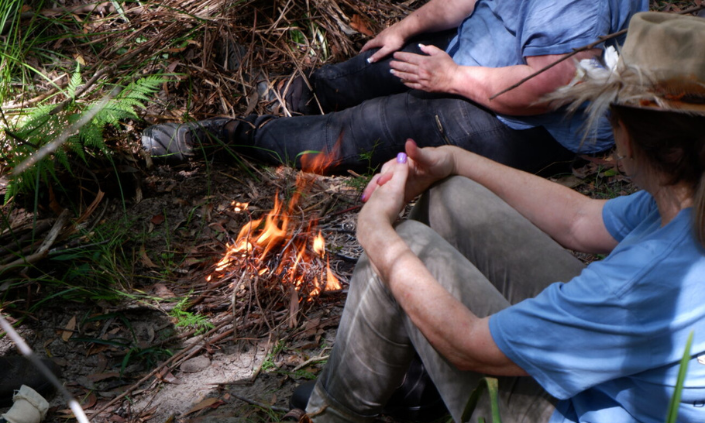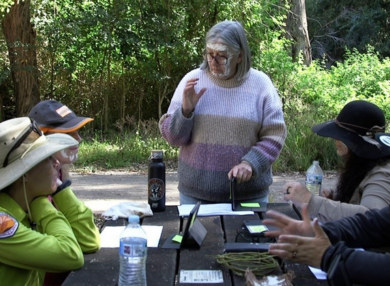Dharug women rekindle tradition of cultural burns
Six Dharug women reignited an Indigenous tradition within Lane Cove National Park with the first women’s-led cultural burn in the area since 1788.

The cultural continuity initiative was led by the Centre of Critical Indigenous Studies at Macquarie University in partnership with local council, the NSW National Parks and Wildlife Service, and the Department of Planning and Environment’s Cultural Fire Management Unit.
Watch: The Cultural Burn Activation at Brown’s Waterhole, April 2024
An important practice for many Indigenous nations, cultural burning – also known as ‘cool burning’ – involves lighting small, controlled fires to remove undergrowth and prevent more destructive fires, while encouraging native seeds to propagate. While cool fires offer carbon to nurture the soil, hot fires burn the soil and devastate future plant life, upon which the animals are dependent.
With climate change anticipated to increase the number and severity of bushfires in Australia, there is growing interest in the revival of cultural burning and other Indigenous forms of caring for Ngurra/Country.
The cultural burn activation took place over four days in April 2024 at Brown’s Waterhole, Lane Cove River - known to Dharug as the Durumbura River. The site was selected for its historic significance as a meeting place, a place of storytelling, and a place of ancestry for some of the women who performed the burn. The initiative signified the return of Dharug presence and their cultural relationship with Country in the area.
A story of nature and community

Historic significance of Brown’s Waterhole
Prior to colonisation, its role as a meeting place involved two neighbourly Dharug communities; the Durumburagal (remembered in the suburban name, Turramurra) and the Wallumattagal (place and people of the Wallumai, the Black Snapper Fish) today covering the areas of Ryde, Hunters Hill, Marsfield, Boronia Park, Putney, Denistone and Eastwood. It is also a place of storying, with Presences carved into the landscape, and 19th and 20th century storying written in the records. Today it is a meeting place for local councils: Ryde, Kuringai and Hornsby. Its naming follows the colonial timber-getting industry which was pursued by descendants of Fanny Randall and her partner, William Brown.
Image: Dharug women Dr Rosemary Norman-Hill and artist Venessa Strazlynski prepare for the camp’s opening ceremony in May 2023.
Preparations for the cultural burn began in 2020, with the Dharug women receiving funding from the Department of Planning and Environment’s Cultural Fire Management Unit to coordinate and carry out the burn alongside Macquarie University researchers. Further collaborations occurred with Ryde City Council and NSW National Parks and Wildlife Service (NPWS) to carry out the activation.
In May 2023, the six Dharug women camped near Brown’s Waterhole for the first time since colonisation, joined by allies including two Dharug men as camp managers, NPWS park rangers, and Macquarie academics. Over the course of three days, the women connected with the site, sharing traditional Dharug knowledge and practices with the group.
The camp began with a smoking ceremony, using ochre from the Blue Mountains, before a series of activities to help build a knowledge base of the area. These included the development of an animal and plant database to understand the living creatures that occupy the area, training in the use of key NPWS equipment for the cultural burn, bush medicine and art workshops to continue the transfer of knowledge and a clean-up of the site. The camp closed with a smoking ceremony using ochre from Wallumatta.
A Cultural Burn Prepping Workshop was then held in March 2024, hosted by the Dharug Women’s and Allies Cultural Fire Alliance in preparation for the official burn in April.
Knowledge spanning millennia
The cultural burn activation at Brown’s Waterhole was the culmination of a three-year postdoctoral project led by Dr Jo Anne Rey, a proud Dharug woman and Research Fellow in the Centre of Critical Indigenous Studies at Macquarie University.
Dr Rey’s doctoral thesis, completed in 2019, explored cultural continuity through the perspectives of seven Dharug women. In 2020 Dr Rey received the Macquarie University Fellowship for Indigenous Research where she explores how Indigenous knowledges and practices are being applied across Country-as-City focusing on Shaw’s Creek Aboriginal Place (Blue Mountains), the Blacktown Native Institution Site, and Brown’s Waterhole.
Drawing on thousands of years of knowledge from the world’s oldest living culture, the project explores how Indigenous ways of knowing, being and doing can inform and co-exist with contemporary land management practices within colonised Country to drive sustainable outcomes. The outcome saw knowledges and materials being transferred from freshwater Country to saltwater Country, restoring Dharug presences, places, and practices across Ngurra.

"Through the research, and alliances with others who are caring for the wellbeing of the river and its biodiversities, Brown’s Waterhole is now a site of regeneration - for Dharug biocultural knowledges and practices, and of cultural fires as a mitigation approach against the likelihood of mega fires in urban environments,” says Dr Rey.
Image: Dr Jo Rey and fellow Dharug women during a camp at Brown’s Waterhole in May 2023.
“Wallumattagal’s connections to the Durumbura Dhurabang/Lane Cove River, Brown’s Waterhole, and the Lane Cove National Park – as well as their proximity to our [Macquarie] campus - offers an opportunity to activate Dharug cultural caring, knowledges and relationships, including through fire, within what is otherwise a highly urbanised area of Dharug Ngurra.”
This exploration represents a priority research stream within the recently established Australian Harmony Centre for Ecosystem Futures ('Harmony Centre'), through which Macquarie and its surrounds act as a ‘living lab’ for nature-based solutions with tangible impact on both a national and global scale.
The Centre was launched in December 2024 in collaboration with Circular Bioeconomy Alliance, for which Macquarie is an affiliate member. The alliance was established by King Charles III during his tenure as the Prince of Wales to support the acceleration of a nature-first, circular bioeconomy that is climate neutral, inclusive and powers prosperity.
Macquarie also is a member of the global Wildfire Resilient Landscapes Network, a joint initiative between the Circular Bioeconomy Alliance and the Commonwealth Secretariat which aims to connect and share unique Indigenous and community knowledge and experience in wildfire management with scientific knowledge and tools.
Walking together with good spirit
Of the project’s success to date, Dr Rey praises the collaborative effort across many groups and organisations that believed in the work being done.
“Underpinning this journey has been the consciousness of ‘yanaldyi budyari gumadawa’ – Dharug-dalang for walking together with good spirit - there has been generous participation across all the stakeholder groups and organisations involved, and relationships between the various partners have been strengthened through this work,” she says.
“It sets a precedent for the future so that other inner urban locations can be nurtured and healed through the traditional custodian’s relationality with the land and the Dharug speaking peoples.”